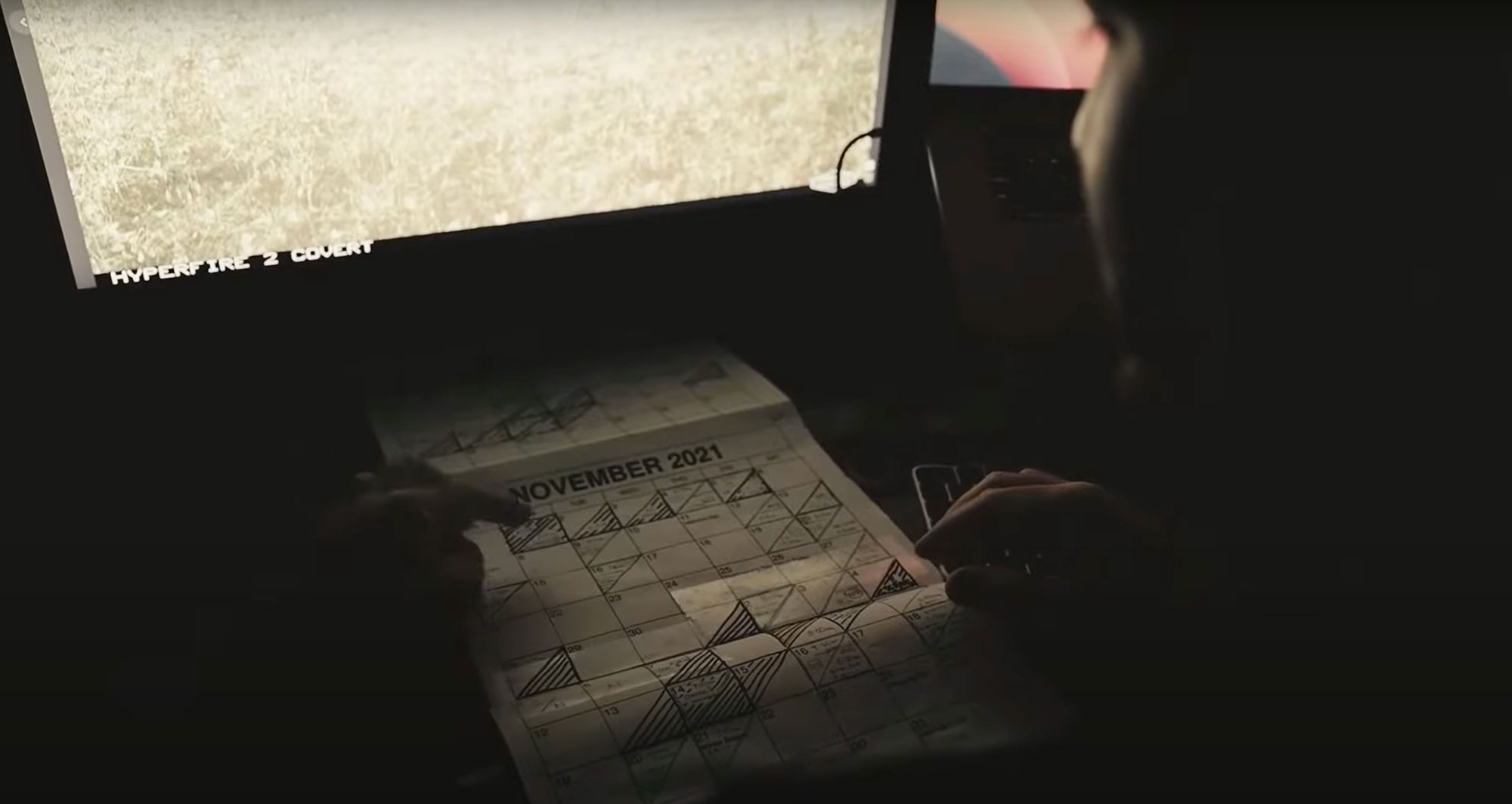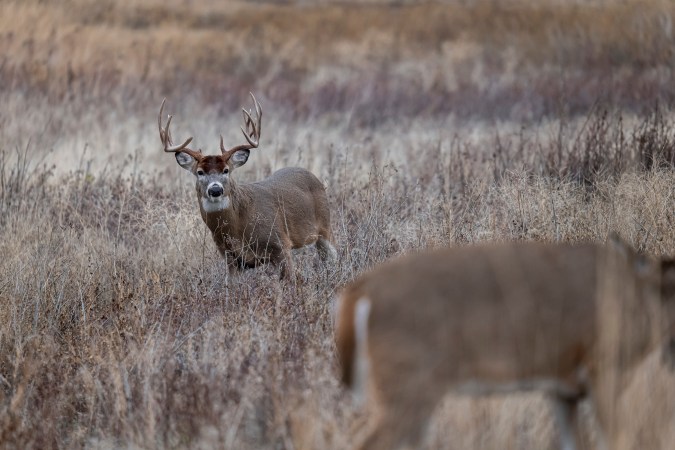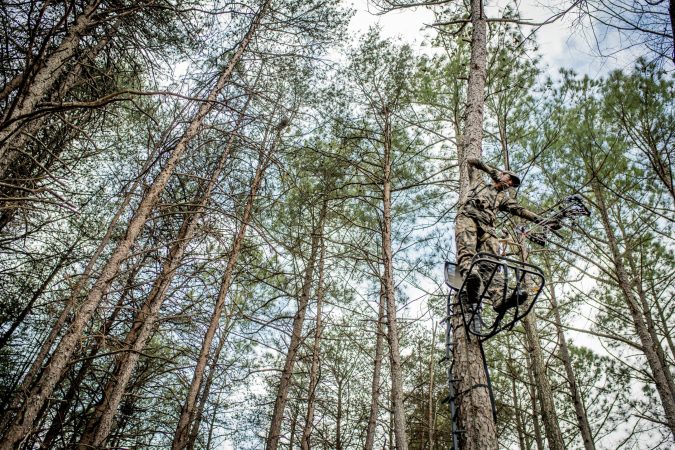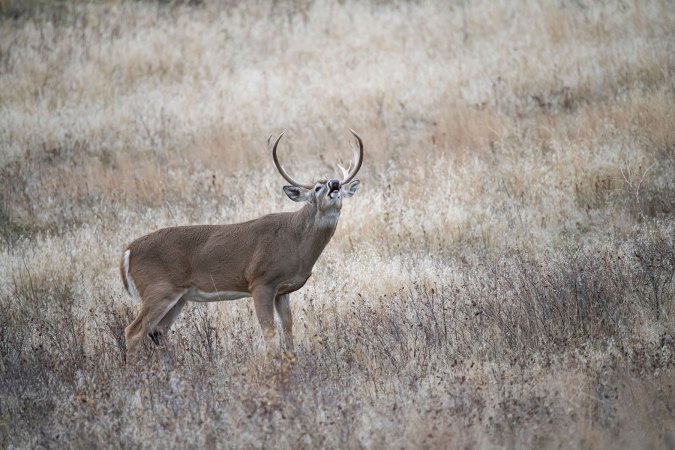As one of the hosts and founders of Heartland Bowhunter, Mike Hunsucker is sometimes forced to hunt aggressively. He travels around the country chasing mature bucks each fall and, because of the logistics and constraints of his show, he usually only has about a week to hunt each location. In that window he’s got to pattern and kill a mature buck, or eat the tag. These days Hunsucker doesn’t eat too many tags.
Over the years he’s developed a knack for knowing when and how to make an aggressive move on a mature buck. Yes, of course it helps that he typically hunts private ground that holds quality deer. But the lessons he’s learned can be applied to wherever you hunt, whether that’s 1,000 acres in Iowa or 80 acres in Pennsylvania.
Last season, Hunsucker had to use all of this knowledge while hunting an estimated seven-year-old buck he nicknamed Floppy—the buck was easily identifiable, with ears that flopped down. Hunsucker had several years of trail camera pictures of Floppy and he’d hunted him for multiple seasons. Even though Floppy would show up on trail cameras during daylight, Hunsucker was never able to truly pattern him the way he had with so many other mature bucks over the years. So when the buck showed up on Hunsucker’s 300-acre Missouri property again last season, he decided to go all in. The Missouri firearms season was about to open and Hunsucker knew that several other hunters in the area were also after the buck. It was time to make a move.
You can hear about how Hunsucker finally tagged Floppy by listening to the podcast episode above. You can also watch the full Heartland Bowhunter episode about the hunt for Floppy when it drops on YouTube the week of November 13. Here are Hunsucker’s keys for hunting elusive old bucks aggressively, but not recklessly.
Zero In on His Bedding Area
One of the first steps is identifying and understanding a mature buck’s bedding area. Hunsucker does this by utilizing cellular trail cameras. From previous experience with Floppy, he knew the buck liked to bed on a timbered ridge—though he didn’t know precisely where on the ridge. Hunsucker set six cellular trail cameras near that bedding area (about a 30-acre area) to figure out when and how Floppy was moving from his bed—and when he was moving back to it. This is key for identifying daytime movement.
“People talk about bucks going nocturnal—and on highly pressured public land areas, sure, I’m sure they get nocturnal—but otherwise most deer are moving during daylight somewhere,” Hunsucker says. “Maybe not on your property, maybe they’re not making it to your camera … But if you’re able to home in on where he’s bedded, you’ll usually find they’re moving at daylight.”
He had cameras set on trails, fence gaps, and scrapes along the perimeter of the bedding area. Because he uses cellular trail cameras, he doesn’t have to worry about creating disturbance while going to check cameras. However Hunsucker didn’t have a camera specifically in the buck’s bedroom, because he’d never go in there in the first place and risk blowing out deer.

Even though Hunsucker relies heavily on cellular trail cams for his hunting strategy, it’s important to know that trail cameras can’t capture everything. And that’s OK. Trail cams are only one tool (not the only tool) we can use to figure out a mature buck.
“The more I’ve been experimenting with trail cameras, it is amazing [to see what they do or don’t capture],” Hunsucker says. “You can have two cameras 100 yards apart and they’re going to have completely different results. Then you could hunt that stand and see 15 deer and the cameras will have maybe five of those deer. So, they can never tell the whole story.”
Read Next: Best Trail Cameras
Have a Stand With “Bulletproof” Access
You might think that with all the trail cameras and focus on this buck, Hunsucker might have a dozen stands hung for him. That wasn’t the case. By October, he had one main stand for hunting Floppy. But the stand was “bulletproof,” meaning that Hunsucker (and his cameraman) could get into it and out of it without spooking deer. They accessed the stand through cattle pastures and a creek and didn’t have to tromp through food sources or bedding areas. Also, larger fields (or the destination food sources) were far away.
“A lot of places I hunt, the food is in the middle of it or pretty close by [the stand] and they’re really tough to get into in the morning. With high deer densities you almost always bust deer [on destination food sources],” Hunsucker says. “This spot, I can slip into in the morning and almost never bump deer. You can have incredible hunts, during the rut, all day.”
Accessing a stand can look different depending on the hunting scenario and the terrain. Regardless of how you do it, you need to avoid bumping deer if you want to kill a mature buck. If you have to bump deer, you want to do so strategically, which leads to Hunsucker’s next tactic.

Make Some Noise When Hanging a New Stand
A big cold front was moving in the week that Hunsucker was planning to hunt Floppy, which meant consistent north wind. Unfortunately, Hunsucker’s bulletproof stand wasn’t bulletproof for a north wind. So Hunsucker decided to hang a new stand for Floppy.
But he wasn’t going to barge into the bedding area just yet. He planned to hang a stand near the same stretch of timber where Floppy bedded. This area was mature, open timber and crunchy dead leaves scattered the ground.
“The last thing I wanted to do, really, was walk in there and spook him,” Hunsucker says.
So instead, he jumped in his side by side and brought along a leaf blower. During the middle of the day Hunsucker drove right into the area he wanted to hang the stand and then used the leaf blower to clear a clean trail for silent stand access later.
“A lot of people might consider that a little crazy,” Hunsucker says. “It was loud, loud as can be. I was walking within 150 to 200 yards of this buck at some point. But sure enough he came off the ridge that evening to the food plot down below. He sat there and let me walk right by him blowing leaves and making all that noise”
The lesson here is that deer, especially in farm country, are used to the disturbances of loud machinery. If they’re bedded, they’ll typically stay in their beds unless a tractor or truck drives right up on them. If deer are out in the open and get spooked by machinery, they’ll typically bound 50 or 100 yards into cover and then turn back to watch the machinery pass by. A human walking into their area, however, represents a much more obvious and predatory threat.
“It was the kind of spot where I couldn’t have just slipped in there and hung a stand,” Hunsucker says. “So I was just going to do it, make all this noise, let things settle, and then get in there and hunt.”
Hunsucker eventually did see Floppy while hunting out of that new stand, but he never got a shot at him.
Read Next: Best Treestands
Hang a Bedding Area Stand at Night
As the hunt progressed, Hunsucker formulated a strategy to hang another stand closer to Floppy’s expected bedding area. To do this he was going to hang the stand at nighttime, while the buck was out feeding. He’d wait till he saw Floppy leave his bedding area (through the use of cellular trail camera photos) and then move in when he knew Floppy was out in a destination food source or off chasing does. This is an ingenious strategy that flips the script on traditional stand-hanging strategies. Most hunters hang stands midday when it’s likely deer are in their beds. If you’re going to hang a stand in or near the bedding area, however, it makes more sense to intrude when you know the buck isn’t there.
“I am an aggressive hunter, but I’m very meticulous with how I do things,” Hunsucker says. “I’m not recklessly aggressive.”
Learn Your Buck’s Personality

Mature bucks often have unique personalities, which sometimes is the very reason they’ve been able to grow to an older age. Floppy was a loner. And, he never seemed to follow a huntable pattern.
“This deer was driving me up a wall,” Hunsucker says. “I had a calendar marked with every time he daylighted, which camera it was on, what direction he came from, which way he was going, what direction the wind was, and I was trying to piece together any kind of pattern. But there just wasn’t one. That was the hardest part. He was the most regular daylight-walking buck with the most irregular pattern.”
What’s remarkable is that Hunsucker had more than three years of data on Floppy and still had not identified a specific routine for him. That seemingly random movement is what made Floppy so unique. Ultimately, it was patience, good shooting, and a little bit of luck that helped Hunsucker kill Floppy.
Eventually the old buck came out to the food plot at the bulletproof stand, lured by a group of does. Hunsucker made a 65-yard shot with his bow and dropped the buck where it stood. Because the buck was impossible to pattern, simply waiting him out (and not bumping him) was the only way to kill him with a bow.
The fact that Hunsucker was hunting the rut also helped. He hunts more conservatively earlier in the season, and is willing to make more aggressive moves during the heat of the rut.
“You can get away with a lot more during the rut,” Hunsucker says. “But it’s a calculated aggressiveness.”
Remember that even the best, most accomplished deer hunters get stumped, too. Even after Hunsucker killed Floppy, he admits he never really had him figured out. He got lucky. And to get lucky, you’ve got to be hunting.
“I just got lucky, finally,” Hunsucker says. “You do everything by the book and do everything you know and he still just had me feeling clueless. I just had luck on my side once, and he had luck on his side all the other times. He was the most intelligent deer that I’ve spent a significant time hunting. There was no doubt that he was smart and he was keen. But he also had to be lucky a time or two.”

































